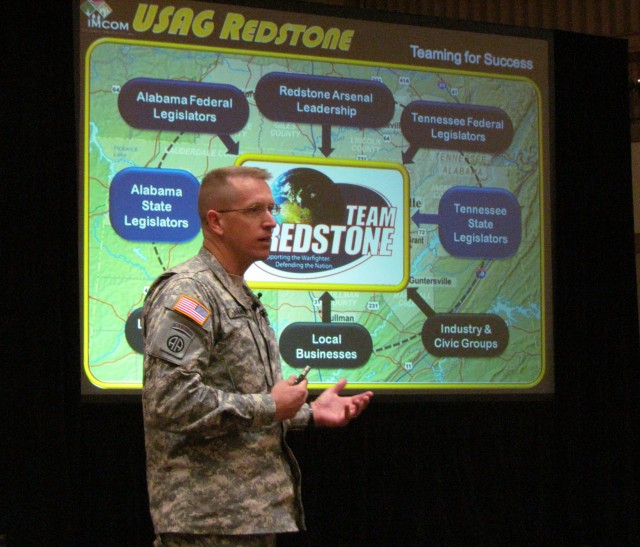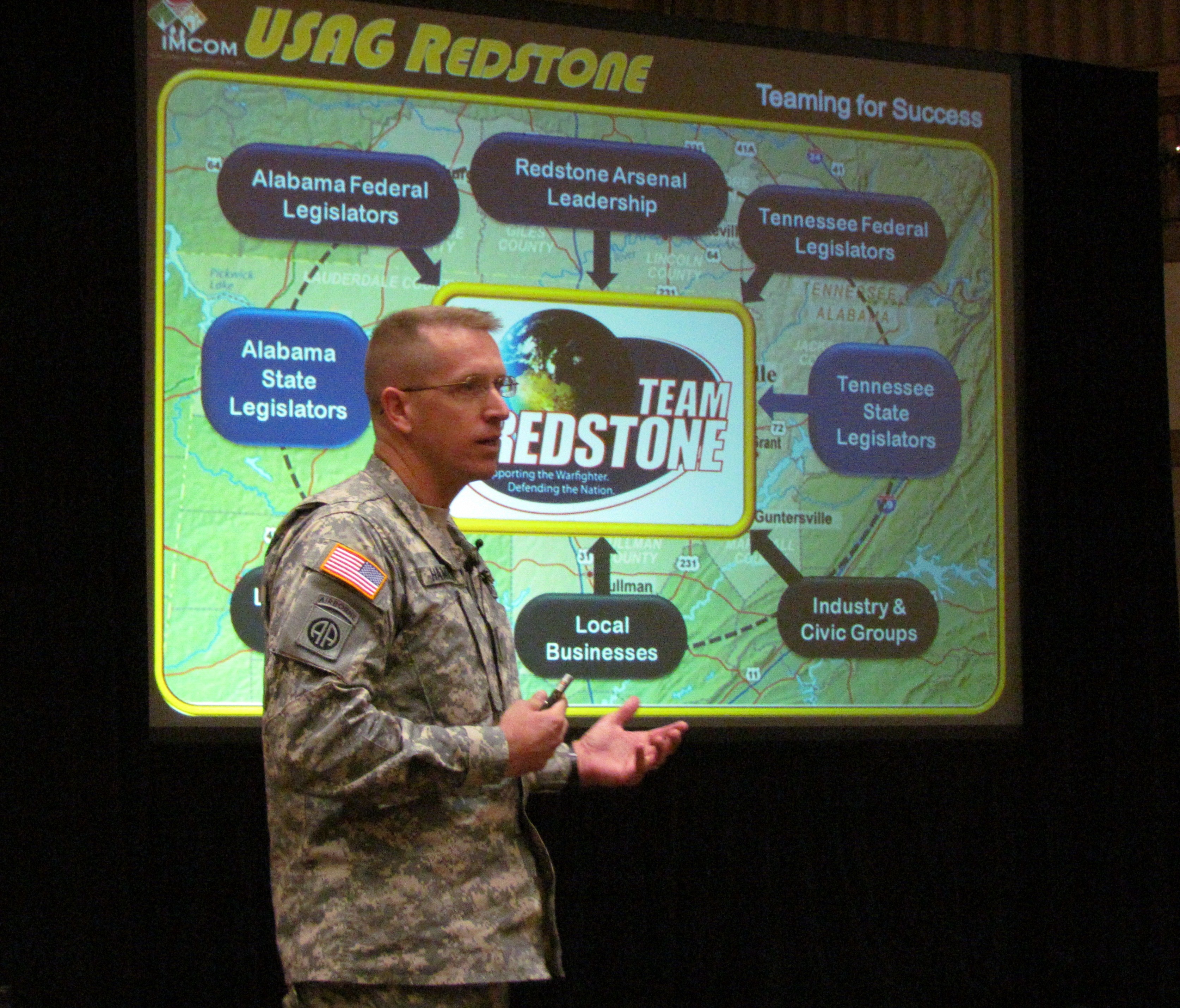
REDSTONE ARSENAL, Ala. -- Garrison commander Col. John Hamilton understands the significance of discussing Redstone Arsenal growth and transition plans with more than 100 business and community leaders at the annual BRAC to the Future community conference which was held Friday at the Von Braun Center.
And in his first community-wide address since taking on Garrison command, Hamilton made it clear to his audience that he appreciated that significance and how it relates to the Soldier in the field.
"Everything we do at Redstone Arsenal is focused on him," Hamilton said, pointing to a photo of a Soldier pictured on a large projection screen.
"The work being done on Redstone Arsenal, with the enhanced use lease project and by our contractors in Cummings Research Park is focused on him. But what makes this special is that I am speaking in a room of mostly civilians focused on him. We have an incredibly powerful team here."
For the fourth year, BRAC to the Future, hosted by the Huntsville/Madison County Chamber of Commerce and the Tennessee Valley BRAC Committee, has brought military and community leaders together to discuss the opportunities and challenges that must be addressed to ensure the success of growth initiated by the Base Realignment and Closure Act of 2005.
During 2011, much of what was mandated by BRAC 2005 will come to fruition, with the opening of such facilities as the Army Materiel Command, Security Assistance Command and Redstone Test Center headquarters and the Missile Defense Agency's development, test, integration and fielding facility at Redstone. With those projects becoming reality, the Tennessee Valley BRAC Committee has its sights on preparing for future BRAC mandates from Congress that could lead to more growth at Redstone.
"We started this in December 2003 (with working for favorable decisions related to BRAC 2005 and then working to ensure a seamless transition to Redstone for incoming organizations and employees). Now we're in the good part of it. We are getting commands here. We are getting people here," said Joe Ritch, chairman of the Tennessee Valley BRAC Committee.
"Now, we are preparing for the next one. We are not sure how it's going to look ... Many people have asked me 'Does the work we do make a difference (in BRAC decisions)' We don't know. But we have to be on the aggressive side and know we've done our best."
With only two months of service as the Arsenal's new Garrison commander, Hamilton described the community as "absolutely phenomenal" and more interconnected than any other military community he has lived in during his career. The concern that the Huntsville/North Alabama/South Tennessee community shows for the growth of Redstone Arsenal and the support it provides the military make it a one-of-a-kind community.
Army leadership knows what's growing in the Tennessee Valley "is a strategic asset not replicated anywhere else in the U.S.," Hamilton said.
Looking back on the history of the Arsenal, the colonel told his audience that Redstone has been a story of "constant growth and constant change."
"BRAC 2005 is part of that. It will continue to grow the federal team. But Redstone Arsenal is much bigger than just DoD. We have to think bigger than that. The BRAC law is bringing a lot of resources to this community. BRAC is a catalyst to growth, and we will be successful if the Arsenal and the community work together."
Hamilton said Sept. 15, 2011, the date when all BRAC 2005 requirements must be complete, is "just one step in the process of where we want to be." He encouraged community and business leaders to look beyond BRAC 2005 to take notice of the non-BRAC-related growth at Redstone and the future of BRAC/non-BRAC growth.
"We can create synergy here using BRAC as a catalyst," he said. "It is bringing 7,000 direct jobs to Redstone Arsenal. It is estimated that we will have a 1 to 3 ratio of indirect and direct growth on the installation due to those jobs. We must prepare Redstone and the Tennessee Valley to receive those people ... A lot of growth going on here is not defined by BRAC law. But that law does bring results, and we must pay attention to third and fourth level results."
Roads, schools, work force recruiting and development, and infrastructure are all needed to make BRAC 2005 successful and to continue the Arsenal's growth beyond BRAC 2005.
BRAC changes as well as projects such as the Redstone Gateway (enhanced use lease) and the Martin Road expansion and the non-BRAC move of Army Contracting Command/Expeditionary Contracting Command to Redstone "are great opportunities to develop more economic engines," Hamilton said.
The Arsenal's mission falls into four main areas - materiel management and acquisition; space operations and missile defense; research, development, test and evaluation; and intelligence and homeland defense. These are the areas that will grow the Arsenal, Hamilton said.
"Transformation of Redstone will continue and must continue ... We must be prepared to receive growth as a community," he said. "What do we want the community to look like' ... Regional growth is outpacing current capabilities. Do we have the right projects on the drawing board'"
Those projects need to, first, focus on education and growing the work force, both now and in the future.
"Employees are only going to come here if they are confident their children will be educated properly," Hamilton said. "Are we growing the engineers, scientists and senior leadership that we will require' Are we preparing our children to work on Redstone Arsenal' ... Our vision has got be expansive. We've got to look down the road pretty broad."
Of the Arsenal's new tenants, the BRAC to the Future audience was given a snapshot of the size and capabilities of the Army Materiel Command, represented by chief of staff Brig. Gen. John Wharton, and the Missile Defense Agency, represented by Harvey Player, special assistant to the executive director.
AMC senior leadership will begin moving to Redstone in January. The command's new facility should be up and running by June.
"We are very excited about coming down here ... BRAC is a top priority. But we also have to maintain our worldwide mission to support our troops," Wharton said. "Thank you for everything you are doing to open up your community to us, and to make this transition easy and seamless."
Once at Redstone, AMC headquarters will consist of 1,121 civilians and 83 military, managing more than 70,000 employees and $92 billion in contracts worldwide. It has an annual budget of $49 billion and operates in every state except Montana and in 144 countries. It has 85 battalion and brigade commands, with six brigades currently deployed to Iraq, Afghanistan and the Gulf State region.
BRAC is affecting about one out of six AMC employees (about 11,000), and is affecting AMC more than any other Army organization.
For MDA, Player told the BRAC audience that the new Von Braun III in the Von Braun Complex will allow the organization to move all its development, test, integration and fielding capabilities to the Arsenal, growing its on-post footprint from 2,591 employees to 4,839 employees.
In all, MDA has invested $374.2 million in its Arsenal facilities, with $56.2 million on Von Braun II, $307.8 million on Von Braun III and $10.2 million on other renovations. Once completed, the 900,000-square-foot Von Braun III will include a 700-person cafeteria, an 800-person auditorium, and a fitness center. The move-in date is now set for April.
In other presentations at the conference, Derrick Boegner, vice president of asset management for Corporate Office Properties Trust, reviewed plans for Redstone Gateway.
"This is the largest enhance use lease in the country right now ... We are creating a gateway. We are creating a prominent image that is fitting," he said. "We are not just building one building, but a 4 and one-half million square foot campus ... It will be a place of transition between Redstone Arsenal, and the contracting and commercial community."
Located near Gate 9, the 468-acre project will include office space and secure office space as well as retail, service, restaurants, a 300-room hotel and conference facilities. The first building will be occupied in 2012.

Social Sharing